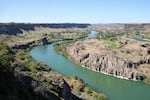A copper-based pesticide will be released into the Snake River this week as the Idaho State Department of Agriculture attempts to eradicate invasive quagga mussels.

ISDA hopes the chemical treatment will eradicate the quagga mussel before a population takes hold in the Snake River.
Rachel Cohen/Boise State Public Radio
The chemical, called Natrix, is known to be toxic to aquatic mussels at all life stages. It had already been specially approved to control invasive mollusks in Idaho by the U.S. Environmental Protection Agency.
ISDA’s treatment will start on Tuesday, Oct. 3, in the Snake River where quagga mussel larvae have been found -- a six-mile stretch between Twin Falls Dam and Centennial Park in Twin Falls County.
Since the initial discovery on Sept. 18, sampling has detected more quagga mussel larvae, particularly near Shoshone Falls. While scuba diving, ISDA staff also found one adult mussel, smaller than the size of a pinky nail, on the bottom of a rock 16 feet under the surface.
The mussels pose a big threat to the entire Columbia River Basin because of the damage they can do to infrastructure, including irrigation, hydropower and drinking water equipment -- destruction that could cost Idaho hundreds of millions of dollars per year. Once there’s an infestation, the mussels are extremely hard to get rid of.
To try to kill the quagga mussels while it’s still possible, Natrix will be introduced to the water to reach a concentration of 1 ppm, a rate that will eradicate mussels, ISDA said, but is below the human drinking water standard. The chemical is likely to kill fish in the area.
“If we do nothing, it is worse for the river,” said ISDA Director Chanel Tewalt during a town hall explaining the treatment plan. “But we want everyone to understand that this treatment doesn’t come without downsides.”
The strategy, which Tewalt described as the “most aggressive” mussel eradication approach tried in the U.S., was developed by ISDA, along with several other state agencies, Idaho Power, canal companies and federal agencies, such as the EPA, the U.S. Fish and Wildlife Service and the U.S. Bureau of Reclamation.
How will the treatment work?
ISDA staff will put 275-gallon metered-gravity totes filled with Natrix in the water at three key sites: Near Twin Falls Dam, Shoshone Falls and Centennial Park.
Tens of thousands of gallons of the chemical will slowly flow out of the boxes during the four-day treatments. Two treatments will be done near Shoshone Falls where the most mussel larvae have been found.
“We need to have that length of time because these guys can hold their breath; they can remain closed,” Jeremey Valley, the ISDA section manager for noxious weeds, said of the quagga mussels.
The chemical is expected to dissolve by 70% when it reaches 16 miles downstream of Centennial Park. The treatments are scheduled to wrap up Oct. 13, after which ISDA will continue monitoring for mussels. The agency could choose to follow up the copper treatment with other chemicals and bacteria for more targeted eradications.
How will the treatment affect drinking water and fish?
ISDA said the chemical is not expected to impact drinking water. The concentration that will be put in the water is lower than the drinking water standard and there aren’t any public drinking water or irrigation intakes near the treatment area. There are some places where livestock drink from the river, but the level of copper is nontoxic to cattle, ISDA said.
However, Natrix will cause “significant morality” of fish in the six-mile river reach from above Shoshone Falls downstream to Auger Falls. That includes hatchery-raised sturgeon. Aquatic plants and algae exposed to the chemical will also die, but mammals and birds are not expected to be affected.
The Idaho Department of Fish and Game has assessed current fish populations to help with future restoration efforts.
What can you do?
Several closures remain in effect as the state implements the treatment and tries to avoid further spread of the mussels. ISDA closed public access to the Snake River from the Twin Falls Hydroelectric Dam to Niagara Springs, and the Idaho Department of Fish and Game has closed hunting, fishing and trapping along the stretch, too.
During the town hall, ISDA staff asked the public to remain patient with the closures.
“We know that it’s an inconvenience and we want that to be as temporary as we can,” said Deputy Director Lloyd Knight.
If your boat, kayak, paddle board or fishing equipment has been in this section of the river in the past month, get your boat decontaminated by ISDA at a hot wash station.
Editor’s note: This story will be updated.
Find reporter Rachel Cohen on Twitter @racheld_cohen
Copyright 2023 Boise State Public Radio